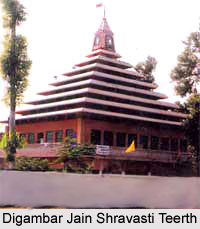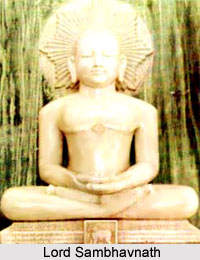 Shri Digambar Jain Shravasti Teerth Kshetra located in Uttar Pradesh is a Jain pilgrimage centre. It is a Kalyanka Teerth. It is dedicated to Lord Sambhavnath, the third Jain Tirthankara. Apart from this there are many other Jain temples located here.
Shri Digambar Jain Shravasti Teerth Kshetra located in Uttar Pradesh is a Jain pilgrimage centre. It is a Kalyanka Teerth. It is dedicated to Lord Sambhavnath, the third Jain Tirthankara. Apart from this there are many other Jain temples located here.
History of Shravasti Teerth Kshetra
According to history Shravasti Teerth Kshetra dates back to the ancient times. It is regarded as a Kalyanka Teerth. This sacred place is associated with the celebrations of Garbha, Janma, Tapa and Gyan of the third Jain Tirthankara, Lord Sambhavnath. He gave his first spiritual speech towards the path of Moksha. It also served as the first place of Samavsharan. Earlier Shravasti has been the centre of powerful states where many business and trade activities were carried out. It was earlier intersected by three major roads that connected it to the main cities and capitals of ancient India. Shravasti has also been visited by Lord Mahavira who stayed here for his Chaturmaas. The principal Ganadhara of Lord Mahavira, Gautam Swami met Muni Keshi here and discussed about different spiritual matters and also cleared their individual doubts. Shravasti has also been the centre of salvation for many ascetic saints. According to Harivansha Purana, Mrigdwaj the son of King Jitshatru had accepted asceticism in the garden of Shravasti. Later he also attained salvation after practicing penance. Another famous businessman of Shravasti Nagdatta also accepted asceticism and also attained salvation. According to Buddhism, Gautama Buddha had practiced penance under a tree up to 15 years here. The tree can still be seen here.
Archaeology of Shravasti Teerth Kshetra
Earlier Shravasti was a famous as Jain Teerth Kshetra with many Temples, Stoopas, Viharas and Columns being located here. King Ashoka and his grandson King Samprati had built several monuments here. Shreshthies i.e. Businessmen of Shravasti also constructed many temples here. However, after the attack of Ala-ud-din Khilji all these magnificent beautiful specimens of temples and other monuments were destroyed. The ruins of these monuments and shrines can be seen in Sahet and Mahet villages and also in close by forests. Ruins of Jain architecture can be seen in Mahet, a place of ancient Shravasti. Sahet is located in the vicinity of Mahet. It is the place of Bauddha Vihar that is ancient Jetvana. Relics of the temples, viharas, stupas and idols dating back to the period of 4th Century B.C. to 12th Century A.D are also visible in Sahet. The idols that have been excavated from here have petrography at their base. According to this petrography it can be said that these were revered in V.S. 1133, 1234. In addition remains of Chaitya Vriksha and idols of religious goddesses have also been found. These stands as an unique piece of art of the mediaeval period. The ruins found here also suggest that there were more 18 temples located here. One of them might have been the birth place of eight Jain Tirthankara Lord Chandraprabha.
Temple of Digambar Jain Shravasti Teerth
 There are two magnificent Jain Temples located at Digambar Jain Shravasti Teerth. These temples have been beautifully decorated with artistic designs and architectural work. The sky high spires adorn the beauty of the temple. The first temple houses the idol of Lord Sambhavnath. It is white in colour and is 3 ft 9 inch in height. The idol is seated in a padmasana posture. The temple is said to have miraculous powers and fulfills the wishes of the devotees visiting the temple and offering prayers with full devotion. It was revered in the year 1966 by organizing a Panch Kalyanka Pratishtha Mahotsav. The second temple houses the idols of 24 Jain Tirthankaras. The main deity of the temple is Lord Sambhavnath. This 84 feet high temple is called Bhagwan Sambhavnath Chaubesee Mandir. The temple was reverenced in the year 1995 and has been magnificently carved. The beautiful sky high spires enhance the beauty of the temple. Another attractive temple also exists here known as the Sobhnath temple. It is dedicated to Lord Sambhavnath. This ancient temple is now completely in ruins. Remains of this temple can now be found here. Many Jain idols have been discovered from here. The Sanctum of the temple is 10 x 10 ft in size. Instead of a spire the temple was adorned by a vault or a dome of Iranian style. The idol of Bhagwan Rishabh Dev being covered by three beautiful umbrellas has been found in one of the rooms of the temple. It was seated on a flat stone in a padmasana posture. Two lions and an ox once flanked the idol of the Lord. The Sobhnath temple was once beautifully carved by the idols of 23 Tirthankaras on a flat stone. The standing images of two Yakshas have also been excavated. It is supposed that the idols in this temple are about 1000 years old.
There are two magnificent Jain Temples located at Digambar Jain Shravasti Teerth. These temples have been beautifully decorated with artistic designs and architectural work. The sky high spires adorn the beauty of the temple. The first temple houses the idol of Lord Sambhavnath. It is white in colour and is 3 ft 9 inch in height. The idol is seated in a padmasana posture. The temple is said to have miraculous powers and fulfills the wishes of the devotees visiting the temple and offering prayers with full devotion. It was revered in the year 1966 by organizing a Panch Kalyanka Pratishtha Mahotsav. The second temple houses the idols of 24 Jain Tirthankaras. The main deity of the temple is Lord Sambhavnath. This 84 feet high temple is called Bhagwan Sambhavnath Chaubesee Mandir. The temple was reverenced in the year 1995 and has been magnificently carved. The beautiful sky high spires enhance the beauty of the temple. Another attractive temple also exists here known as the Sobhnath temple. It is dedicated to Lord Sambhavnath. This ancient temple is now completely in ruins. Remains of this temple can now be found here. Many Jain idols have been discovered from here. The Sanctum of the temple is 10 x 10 ft in size. Instead of a spire the temple was adorned by a vault or a dome of Iranian style. The idol of Bhagwan Rishabh Dev being covered by three beautiful umbrellas has been found in one of the rooms of the temple. It was seated on a flat stone in a padmasana posture. Two lions and an ox once flanked the idol of the Lord. The Sobhnath temple was once beautifully carved by the idols of 23 Tirthankaras on a flat stone. The standing images of two Yakshas have also been excavated. It is supposed that the idols in this temple are about 1000 years old.
Apart from these there are other temples located here. A striking Swetambara Jain Temple is located here. A Bauddha Mandir was constructed by the government of Sri Lanka. In the centre of garden of Shravasti a Gong was also established by the government of Japan. It almost weighs 3.5 tons and its sound can be heard even from a distance. One can also see the cave of Angulimala, a famous dacoit during the time of Buddha.
Digambar Jain Shravasti Teerth is surrounded by scenic beauty that mesmerizes the pilgrims. The peaceful and tranquil environment and the natural greenery of the place attract many devotees. The temple organises many annual gatherings. Bhagwan Sambhavnath Jayanti and Ratha Yatra are celebrated every year on the Kartika Shukla. Bhagwan Sambhavnath Nirvanotsava is also organised on Chitra Shukla. The temple has provisions for dharamshalas or rest houses for the pilgrims. These are well equipped with all modern facilities. Digambara Jain Dharmashala, Swetambara Jain Dharmashala are some of the rest houses located here.
Digambar Jain Shravasti Teerth is well connected to road, rail and air. Busses from KesarBag bus stand of Lucknow are easily available for Shravasti. Buses and Taxies from Bahraich available every time. The nearest airport is located at Lucknow.




















